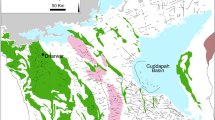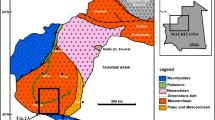Abstract
The basic dyke swarms, which have been deformed and metamorphosed, are widespread in the Wudang block. They are geochemicaiiy characterized by the continental tholeiites, and their Sm-Nd isochron age is (782 ±164) Ma. All of these indicate that there was an ancient continental block In the Proterozoic and a rifting occurring on this continental block during ±800 Ma.
Similar content being viewed by others
References
Zhang Gwwei, Zhang Zongqin, Dong Yunpeng, Nature of main tectono-lithoatratigraphic units of the Qinling Orogm: Implications for the tectonic evolution,Actn Pctrologica Sinica (in Chinese). 1995, 11(2): 101.
Zhang Zongqin. Zhang Guowei, Fu Gwminget al., Ages of metamorphic strata in Qinling belt and its tectonic significe,Science in China, Ser. D, 1996, 39(3): 283.
Qin Zhengyong. Lei Shihe, New data of ages of Wudang Group and its discussion,Regional Geology of China (in Chinese), 1996, 42(2): 176.
Zhou Dingwu, Liu Liang, A discussion of the middle and late Proterozoic tectonic regime of Qinling-Dabie Omgenic Belt,Journal of Northwst University (in Chinese). 1996, 26: 133.
Cheng Yuqi,Outline of Regional Geology of China (in Chinese), Beijing: Geological Publishing House, 1994, 170.
Brian, F. W.,The Ewlwing Continents, New York: John Wiley and Sons, 1984.
Author information
Authors and Affiliations
About this article
Cite this article
Zhou, D., Zhang, C., Wang, J. et al. The basic dyke swarms in the Wudang block and its geological significance. Chin.Sci.Bull. 43, 1111–1115 (1998). https://doi.org/10.1007/BF02883083
Received:
Issue Date:
DOI: https://doi.org/10.1007/BF02883083




